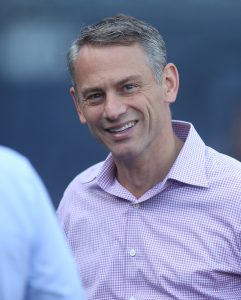Jed Hoyer, president of baseball operations for the Chicago Cubs, spoke with reporters (including Bruce Levine of of 670 The Score and Sahadev Sharma of The Athletic) on Friday about the upcoming offseason. Hoyer said that the organization plans on being “really active in free agency,” though also hedged that by saying they plan to “spend money intelligently.”
One could be forgiven for being a bit skeptical of Hoyer, given how his tenure as president has gone so far. After taking over for the departing Theo Epstein in November of 2020, it took him just over a month to trade away the team’s ace, Yu Darvish, a move that seemed entirely motivated by ownership-mandated cost savings and was essentially unprecedented. If that wasn’t a total wave of the white flag on the season, then the trade deadline was, as the Cubs shipped out almost all of their curse-breaking core by trading away Anthony Rizzo, Javier Baez and Kris Bryant, as well as Craig Kimbrel and a few others.
After almost a year of stripping the roster down, it’s hard to believe that the front office will suddenly turn around and spend at the top of the market in an attempt to make a quick return to competitiveness. However, there’s not going to be much stopping them from spending this winter, financially speaking. Due to all the aforementioned trades, they now have just over $40MM in guaranteed money on the books for 2022, most of which is going to Jason Heyward and Kyle Hendricks, per Roster Resource’s Jason Martinez. Willson Contreras and Ian Happ will be owed arbitration raises and add modest sums to that, but that will probably only push the total to the $60MM range. The Cubs haven’t had a payroll below $100MM since 2014, according to Cot’s Baseball Contracts, when prorating 2020’s payroll over a full season. So, there could be lots of money for Hoyer to throw around, if ownership allows him. But based on the past year, that’s a big if.
Given all the holes on the roster created by the teardown, it seems more likely that the club will make a few modest signings and continue to give most of their playing time to cheaper and controllable players. With the departure of the previous core, they didn’t really have highly-touted prospects to call up and fill the void. Instead, the playing time has gone to late-bloomer types like 30-year-old Rafael Ortega and 29-year-olds Patrick Wisdom and Frank Schwindel. Although those guys have fared well in their auditions since the deadline, they’re generally not the kinds of players that front offices consider building blocks.
In addition to the roster, Hoyer will also be dealing with other matters, such as signing a general manager. In Sharma’s piece from The Athletic, and a separate piece from Levine, they say the plan is to make a hire before the general managers’ meetings. A date is not yet set for this year’s meetings, though they usually take place annually in November. Levine’s sources say the Cubs have “had contact with upward of six individuals” about the position, though no names are mentioned.
As for the manager’s seat, Sharma suggests the plan there is more straightforward. David Ross is about to finish the second season of a three-year deal, though he could be a candidate for an extension. When asked about the possibility of an extension, Hoyer said, “I think that’s a question for next week… But it’s a fair question next week. And like I said, I love working with him. He’s already an excellent manager, and I think he has a chance to be really special in his job.”
All in all, it will surely be a very different offseason than the Cubs have had in some time, with one competitive window now firmly closed and all efforts focused on opening the next one.
